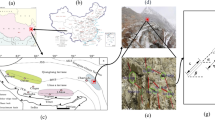Abstract
The objective of this paper is to study analytically the transition phenomenon between a large single curvilinear crack and diagnoal multiple cracks observed during the shear-off failure sequence of concrete shear key joints. Based on the principle of the conservation of strain energy, well-known elastic solutions are applied to analyze the principal strain distribution along the shear key base after a large single curvilinear crack propagation. The analytical prediction is compared with the principal strain distribution obtained by the smeared crack FEM analysis. The analytical model is found in relatively good agreement with FEM analysis, indicating that the nonlinear strain localization at the cracking transition could be quantified in a simple manner to a certain extent. In addition, it is analytically clarified that the cracking transition is induced by the change of the boundary condition.
Résumé
L'objectif de cet article est l'étude analytique du phénomène transitoire entre une grande et unique fissure curviligne et de multiples fissures diagonales observées pendant la séquence de la défaillance détachée du béton clé d'écart. Conformément au principe de conservation de l'énergie de déformation, les solutions bien connues sont appliquées pour analyser la distribution des déformations le long de la base de la clé après la propagation d'une large fissure curviligne. La prévision analytique est comparée avec la distribution de la déformation principale obtenue par l'analyse FEM. Le modèle se trouve en corrélation satisfaisante avec l'analyse FEM. Ceci indique que la localisation non linéaire des déformations, dans la phase de fissuration, pourrait être quantifiée de façon simple, jusqu'à un certain point.
De plus, il est montré de façon analytique que la phase de fissuration est affectée par un changement des conditions aux limites.
Similar content being viewed by others
References
Cholewicki, A., ‘Loadbearing capacity and deformability of vertical joints in structural walls of large panel buildings’,Building Science 6 (1971) 163–184.
Koseki, K. and Breen, J. E., ‘Exploratory Study of Shear Strength of Joints for Precast Segmental Bridges’, Research Report No. 248-1, Center for Transportation Research, Bureau of Engineering Research, University of Texas at Austin (1983).
Bakhoum, M. M., ‘Shear Behavior and Design of Joints in Precast Concrete Segmental Bridges’, Ph.D. Thesis, Massachusetts Institute of Technology (1991).
Ingraffea, A. R. and Panthaki, M. J., ‘Analysis of Shear Fracture Tests of Concrete Beams’, U.S.-Japan Seminar on Finite Element Analysis of Reinforced Concrete Structures, Tokyo, (May 21–24, 1985) 71–91.
Watkins, J. and Liu, K. L. W., ‘A finite element study of the short beam test specimen under mode II loading’,International Journal of Cement Composites and Lightweight Concrete 7 (1) (1985) 39–47.
Bažant, Z. P. and Pfeiffer, P. A., ‘Shear Fracture Tests of Concrete’,Mater. Struct. 19 (1986) 111–121.
Davies, J., ‘Numerical study of punch-through shear specimen in mode II testing for cementitious materials’,International Journal of Cement Composites and Lightweight Concrete (1988) 3–14.
Petit, J.-P., ‘Normal stress dependent rupture morphology in direct shear tests on sandstone with applications to some natural fault surface features’,Int. J. Rock Mech. Min. Sci. & Geomech. Abstr. 25 (6) (1988) 411–419.
Barr, B. and Derradj, M., ‘Numerical study of a shear (Mode II) type test specimen geometry’,Engineering Fracture Mechanics 35 (1/2/3) (1970) 171–180.
Petit, J.-P. and Barquins, M., ‘Can natural Faults propagate under mode II conditions?’,Tectonics 7 (6) (1988) 1243–1256.
Einstein, H. H. and Dershowitz, W. S., ‘Tensile and shear fracturing in predominantly compressive stress fields—A review’,Engineering Geology 29 (2) (1990) 149–172.
Kaneko, Y., Connor, J. J., Triantafillou, T. C. and Leung, C. K., ‘Fracture mechanics approach for failure of concrete shear key. I: Theory’,J. of Eng. Mechanics 119 (4) (1993) 681–700.
Kaneko, Y., Connor, J. J., Triantafillou, T. C. and Leung, C. K., ‘Fracture mechanics approach for failure of concrete shear key. II: Verification’, 701–719.
Volterra, E. and Gaines, J.H., ‘Advanced Strength of Materials’ (Prentice-Hall, Inc., Englewood Cliffs., N.J., 1971).
Hillerborg, A., ‘Numerical Methods to Simulate Softening and Fracture of Concrete’, in ‘Fracture Mechanics of Concrete: Structural Application and Numerical Calculation’, (Martinus Nijhoff Publishers, 1985) 141–170.
‘Building code requirements for reinforced concrete’ (ACI 318-89, American Concrete Institute, Detroit, Michigan, 1989).
Chen, W. F., ‘Plasticity in Reinforced Concrete’ (McGraw-Hill Book Company, 1982).
Rots, J. G. and Blaauwendraad, J., ‘Crack models for concrete: discrete or smeared?. Fixed, multidirectional or rotating?’HERON 34 (1) 1989.
Balakrishnan, S. and Murray, D., ‘Concrete Constitutive Model for NLFE Analysis of Structures’ASCE ST7 114 (July 1988).
Rots, J. G., ‘Computational Modeling of Concrete Fracture’, Dissertation, Delft University of Technology (1988).
Author information
Authors and Affiliations
Additional information
Editorial Note Prof. H. Mihashi is a RILEM Senior Member and a Member of the Board of Advisers. He participates in the work of RILEM Technical Committees TC 129-MHT (Tests methods for mechanical properties of concrete at high temperatures), TC IDC (Internal damage of concrete due to frost action) and TC QFS (Size effect and scaling of quasibrittle fracture).
Rights and permissions
About this article
Cite this article
Kaneko, Y., Mihashi, H. Analytical study on the cracking transition of concrete shear key. Mat. Struct. 32, 196–202 (1999). https://doi.org/10.1007/BF02481515
Received:
Accepted:
Issue Date:
DOI: https://doi.org/10.1007/BF02481515




